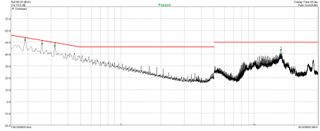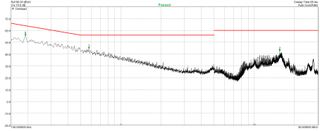Corsair AX850 PSU Review: Top Performer and Dead Silent
Why you can trust Tom's Hardware
Transient Response Tests, Ripple Measurements and EMC Pre-Compliance Testing
Advanced Transient Response Tests
For details on our transient response testing, please click here.
In the real world, power supplies are always working with loads that change. It's of immense importance, then, for the PSU to keep its rails within the ATX specification's defined ranges. The smaller the deviations, the more stable your PC will be with less stress applied to its components.
Advanced Transient Response at 20 Percent – 200ms
| Voltage | Before | After | Change | Pass/Fail |
|---|---|---|---|---|
| 12V | 12.242V | 12.202V | 0.33% | Pass |
| 5V | 5.054V | 5.007V | 0.93% | Pass |
| 3.3V | 3.373V | 3.301V | 2.13% | Pass |
| 5VSB | 5.040V | 4.994V | 0.91% | Pass |
Advanced Transient Response at 20 Percent – 20ms
| Voltage | Before | After | Change | Pass/Fail |
|---|---|---|---|---|
| 12V | 12.240V | 12.144V | 0.78% | Pass |
| 5V | 5.054V | 4.997V | 1.13% | Pass |
| 3.3V | 3.374V | 3.288V | 2.55% | Pass |
| 5VSB | 5.040V | 5.003V | 0.73% | Pass |
Advanced Transient Response at 20 Percent – 1ms
| Voltage | Before | After | Change | Pass/Fail |
|---|---|---|---|---|
| 12V | 12.239V | 12.168V | 0.58% | Pass |
| 5V | 5.054V | 4.997V | 1.13% | Pass |
| 3.3V | 3.374V | 3.285V | 2.64% | Pass |
| 5VSB | 5.040V | 5.001V | 0.77% | Pass |
Advanced Transient Response at 50 Percent – 200ms
| Voltage | Before | After | Change | Pass/Fail |
|---|---|---|---|---|
| 12V | 12.231V | 12.196V | 0.29% | Pass |
| 5V | 5.047V | 5.001V | 0.91% | Pass |
| 3.3V | 3.370V | 3.295V | 2.23% | Pass |
| 5VSB | 5.027V | 4.988V | 0.78% | Pass |
Advanced Transient Response at 50 Percent – 20ms
| Voltage | Before | After | Change | Pass/Fail |
|---|---|---|---|---|
| 12V | 12.229V | 12.180V | 0.40% | Pass |
| 5V | 5.048V | 4.992V | 1.11% | Pass |
| 3.3V | 3.371V | 3.281V | 2.67% | Pass |
| 5VSB | 5.027V | 4.979V | 0.95% | Pass |
Advanced Transient Response at 50 Percent – 1ms
| Voltage | Before | After | Change | Pass/Fail |
|---|---|---|---|---|
| 12V | 12.229V | 12.188V | 0.34% | Pass |
| 5V | 5.048V | 4.993V | 1.09% | Pass |
| 3.3V | 3.371V | 3.280V | 2.70% | Pass |
| 5VSB | 5.027V | 4.990V | 0.74% | Pass |






The transient response is fantastic on all rails! The AX850 is not only highly efficient, but also capable of handling tough transient response scenarios without sweating.
Turn-On Transient Tests
In the next set of tests, we measure the PSU's response in simpler transient load scenarios—during its power-on phase. Ideally, we don't want to see any voltage overshoots or spikes since those put a lot of stress on the DC-DC converters of installed components.



The results are good, since we don't notice any large spikes or voltage overshoots.
Ripple Measurements
Ripple represents the AC fluctuations (periodic) and noise (random) found in the PSU's DC rails. This phenomenon significantly decreases the capacitors' life span because it causes them to run hotter. A 10°C increase can cut into a cap's useful life by 50 percent. Ripple also plays an important role in overall system stability, especially when overclocking is involved.
The ripple limits, according to the ATX specification, are 120mV (+12V) and 50mV (5V, 3.3V, and 5VSB).
| Test | 12V | 5V | 3.3V | 5VSB | Pass/Fail |
|---|---|---|---|---|---|
| 10% Load | 6.7 mV | 4.3 mV | 8.6 mV | 6.8 mV | Pass |
| 20% Load | 8.3 mV | 4.6 mV | 9.0 mV | 7.1 mV | Pass |
| 30% Load | 9.2 mV | 5.2 mV | 9.6 mV | 7.2 mV | Pass |
| 40% Load | 5.7 mV | 5.8 mV | 9.9 mV | 8.0 mV | Pass |
| 50% Load | 5.6 mV | 4.7 mV | 9.7 mV | 8.0 mV | Pass |
| 60% Load | 6.0 mV | 5.1 mV | 9.7 mV | 8.5 mV | Pass |
| 70% Load | 6.7 mV | 5.0 mV | 10.3 mV | 8.3 mV | Pass |
| 80% Load | 6.9 mV | 5.1 mV | 10.6 mV | 8.9 mV | Pass |
| 90% Load | 6.8 mV | 5.1 mV | 10.4 mV | 8.1 mV | Pass |
| 100% Load | 10.8 mV | 5.8 mV | 11.8 mV | 9.6 mV | Pass |
| 110% Load | 10.9 mV | 5.7 mV | 12.5 mV | 10.1 mV | Pass |
| Crossload 1 | 8.9 mV | 5.1 mV | 12.0 mV | 7.8 mV | Pass |
| Crossload 2 | 10.9 mV | 5.5 mV | 10.7 mV | 9.6 mV | Pass |




The ripple suppression is great on all rails, especially at 5V where it doesn't exceed 10mV even in the worst case scenario. Obviously the addition of in-cable caps plays a role here.
Ripple At Full Load




Ripple At 110-Percent Load




Ripple At Cross-Load 1




Ripple At Cross-Load 2




EMC Pre-Compliance Testing – Average & Peak EMI Detector Results
Electromagnetic Compatibility (EMC) is the ability of a device to operate properly in its environment without disrupting the proper operation of other close-by devices.
Electromagnetic Interference (EMI) stands for the electromagnetic energy a device emits, and it can cause problems in other close-by devices if too high. For example it can be the cause of increased static noise in your headphones or/and speakers.
Average EMI Detector

Peak EMI Detector

The conducted EMI emissions are below the corresponding limits with both average and peak detectors.
MORE: Best Power Supplies
MORE: How We Test Power Supplies
MORE: All Power Supply Content
Current page: Transient Response Tests, Ripple Measurements and EMC Pre-Compliance Testing
Prev Page Protection Features, DC Power Sequencing, Cross-Load Tests & Infrared Images Next Page Performance, Noise and EfficiencyStay on the Cutting Edge
Join the experts who read Tom's Hardware for the inside track on enthusiast PC tech news — and have for over 25 years. We'll send breaking news and in-depth reviews of CPUs, GPUs, AI, maker hardware and more straight to your inbox.
Aris Mpitziopoulos is a Contributing Editor at Tom's Hardware US, covering PSUs.